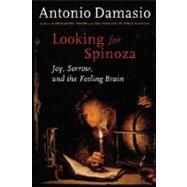
Note: Supplemental materials are not guaranteed with Rental or Used book purchases.
Purchase Benefits
| Enter Feelings | |
| Enter Feelings | p. 3 |
| The Hague | p. 8 |
| Looking for Spinoza | p. 15 |
| Beware | p. 17 |
| In the Paviljoensgracht | p. 23 |
| Of Appetites and Emotions | |
| Trust Shakespeare | p. 27 |
| Emotions Precede Feelings | p. 29 |
| A Nesting Principle | p. 37 |
| More on the Emotion-Related Reactions: From Simple Homeostatic Regulation to Emotions-Proper | p. 38 |
| The Emotions of Simple Organisms | p. 40 |
| The Emotions-Proper | p. 43 |
| A Hypothesis in the Form of a Definition | p. 53 |
| The Brain Machinery of Emotion | p. 54 |
| Triggering and Executing Emotions | p. 57 |
| Out of the Blue | p. 65 |
| The Brain Stem Switch | p. 73 |
| Out-of-the-Blue Laughter | p. 74 |
| Laughter and Some More Crying | p. 77 |
| From the Active Body to the Mind | p. 79 |
| Feelings | |
| What Feelings Are | p. 83 |
| Is There More to Feelings than the Perception of Body State? | p. 89 |
| Feelings Are Interactive Perceptions | p. 91 |
| Mixing Memory with Desire: An Aside | p. 93 |
| Feelings in the Brain: New Evidence | p. 96 |
| A Comment on Related Evidence | p. 101 |
| Some More Corroborating Evidence | p. 104 |
| The Substrate of Feelings | p. 105 |
| Who Can Have Feelings? | p. 109 |
| Body States versus Body Maps | p. 111 |
| Actual Body States and Simulated Body States | p. 112 |
| Natural Analgesia | p. 113 |
| Empathy | p. 115 |
| Hallucinating the Body | p. 118 |
| The Chemicals of Feeling | p. 119 |
| Varieties of Drug-Induced Felicity | p. 121 |
| Enter the Naysayers | p. 124 |
| More Naysayers | p. 126 |
| Ever Since Feelings | |
| Of Joy and Sorrow | p. 137 |
| Feelings and Social Behavior | p. 140 |
| Inside a Decision-Making Mechanism | p. 144 |
| What the Mechanism Accomplishes | p. 147 |
| The Breakdown of a Normal Mechanism | p. 150 |
| Damage to Prefrontal Cortex in the Very Young | p. 152 |
| What If the World? | p. 155 |
| Neurobiology and Ethical Behaviors | p. 159 |
| Homeostasis and the Governance of Social Life | p. 166 |
| The Foundation of Virtue | p. 170 |
| What Are Feelings For? | p. 175 |
| Body, Brain, and Mind | |
| Body and Mind | p. 183 |
| The Hague, December 2, 1999 | p. 184 |
| The Invisible Body | p. 187 |
| Losing the Body and Losing the Mind | p. 191 |
| The Assembly of Body Images | p. 195 |
| A Qualification | p. 198 |
| The Construction of Reality | p. 198 |
| Seeing Things | p. 200 |
| About the Origins of the Mind | p. 204 |
| Body, Mind, and Spinoza | p. 209 |
| Closing with Dr. Tulp | p. 217 |
| A Visit to Spinoza | |
| Rijnsburg, July 6, 2000 | p. 223 |
| The Age | p. 224 |
| The Hague, 1670 | p. 227 |
| Amsterdam, 1632 | p. 230 |
| Ideas and Events | p. 236 |
| The Uriel da Costa Affair | p. 240 |
| Jewish Persecution and the Marrano Tradition | p. 245 |
| Excommunication | p. 250 |
| The Legacy | p. 254 |
| Beyond the Enlightenment | p. 258 |
| The Hague, 1677 | p. 261 |
| The Library | p. 262 |
| Spinoza in My Mind | p. 263 |
| Who's There? | |
| The Contented Life | p. 267 |
| Spinoza's Solution | p. 273 |
| The Effectiveness of a Solution | p. 277 |
| Spinozism | p. 279 |
| Happy Endings? | p. 283 |
| Appendices | p. 291 |
| Notes | p. 299 |
| Glossary | p. 333 |
| Acknowledgments | p. 337 |
| Index | p. 339 |
| Table of Contents provided by Syndetics. All Rights Reserved. |
The New copy of this book will include any supplemental materials advertised. Please check the title of the book to determine if it should include any access cards, study guides, lab manuals, CDs, etc.
The Used, Rental and eBook copies of this book are not guaranteed to include any supplemental materials. Typically, only the book itself is included. This is true even if the title states it includes any access cards, study guides, lab manuals, CDs, etc.
Excerpted from Looking for Spinoza: Joy, Sorrow, and the Feeling Brain by Antonio Damasio
All rights reserved by the original copyright owners. Excerpts are provided for display purposes only and may not be reproduced, reprinted or distributed without the written permission of the publisher.